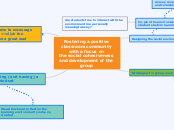Fostering a positive classroom community with a focus on
the social cohesiveness and development of the group
Designing the social environment
Empower student learning through collaboration
Give weight to student voice
Focus on student solutions and interpretations
Encourage real-world problem solving
Build self-efficacy
Strategies for group work
Have students think on their own before engaging in a "team talk" (get students used to this by structuring your lessons to always let them think on their own first); then discuss as whole class (so when students get called on, they've had some experience with the topic)
Give students roles
Helps to build confidence in ability
Encourage students to try, fail, try again
Positive norms to encourage (Jo Boaler) <--click the hyperlink for a great read
Everyone can learn math to the highest levels
Mistakes are valuable
Questions are really important
Math is about connections & communicating
Depth is more important than speed
Math class is about learning, not performing
Math is about creativity and making sense
Encouraging (and having) a growth mindset
Ability and intelligence grow with effort and practice (intelligence is math is NOT fixed)
Use open tasks
We can all grow from mistakes; mistakes are important
Teacher's mindset = must believe everyone can grow
Ability grouping communicates a damaging fixed mindset belief to students
